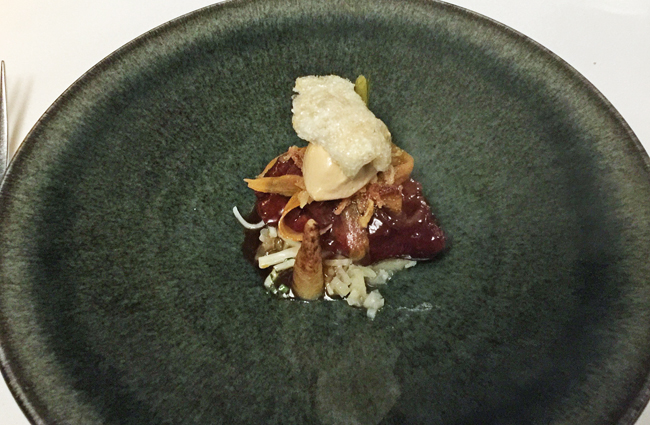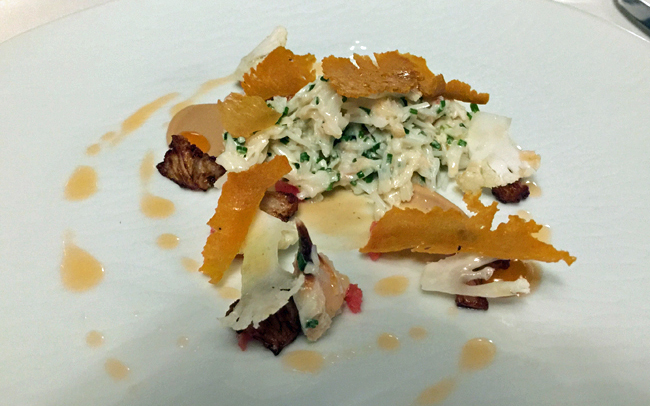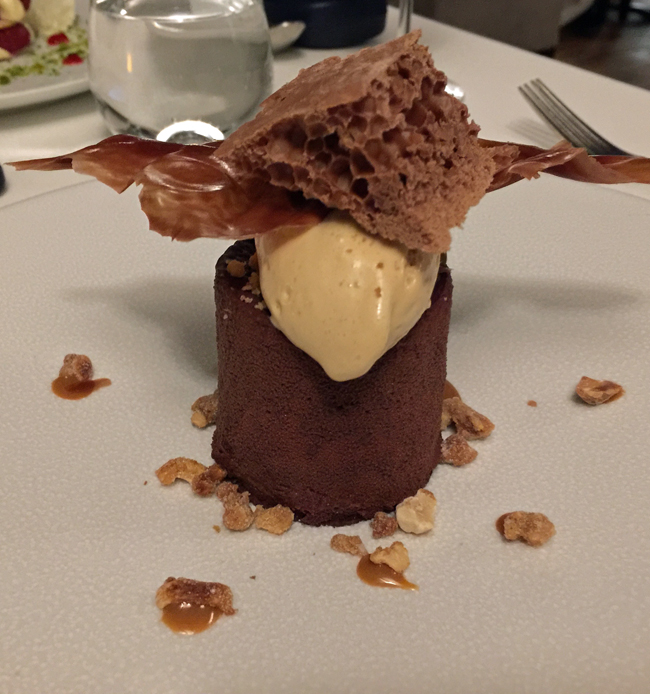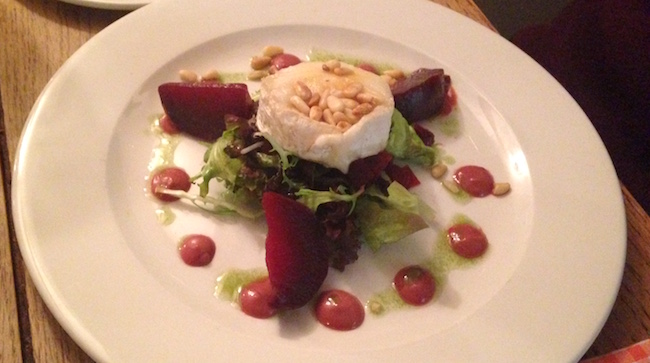
Restaurants with rooms have been well established in France for many years but are a comparatively recent development in the UK. With all diners, including the driver, wanting to relax after the soporific effects of a great dinner with matching wines, the advantages of a stay are patently clear.
For chef patrons, the need to please an increasingly discerning clientele presents a double challenge. Foremost, the standard of cuisine must be high enough to justify often long journeys to (sometimes) remote rural locations. Almost as important is the standard of accommodation, which must offer a degree of comfort, style and design that can compete with country house hotels without incurring the same, sometimes hefty, expense.
The Whitebrook – formerly known as the Crown at Whitebrook – delivers impressively on both fronts. Set in the Wye Valley, within easy driving distance of Chepstow, Monmouth and Tintern Abbey, it is an ideal base from which to explore an area of outstanding natural beauty and historical interest.
The accommodation, eight rooms graded five stars by the AA and Welsh Tourist Board for restaurants with rooms, is stylish and comfortable. Room 3 where we stayed was one of four redesigned and refurbished rooms on the first floor. Decorated in natural tones – Farrow and Ball “Elephant’s breath” – with tree patterned heavy fabric curtains, the interior harmonised with the view of the valley outside. Spotlights and elegant bed side lighting gave a seductive glow. The super king sized bed, dressed in the finest linen, provided a most comfortable night’s sleep.

The new ensuite bathroom with spacious monsoon shower and large double ended bath was clearly designed for couples. Fluffy towels and bathrobes, and a heated towel rail, added to the sense of indulgent luxury.
Fresh milk with tea and coffee – including a cafetiere – home-made oatcakes, still and sparking mineral water, and Sedbergh natural organic toiletries showed pleasing attention to detail. The only suggestion for improvement, which can easily be rectified, would be a full length mirror. This minor shortcoming did not detract from a most agreeable stay in the peace and stillness of the Welsh countryside.
 Guests come primarily to sample the acclaimed cooking of Chris Harrod, Chef Patron since October 2013. His unassuming and quietly spoken persona belies a strong passion and clear vision for the direction of his innovative cuisine. He succeeded the Michelin starred James Sommerlin but gained the same distinction in less than a year. Other awards now include three AA rosettes, 5/10 in the 2015 Good Food Guide – a notoriously hard marker – and inclusion in Sawday’s and the Good Hotel Guides.
Guests come primarily to sample the acclaimed cooking of Chris Harrod, Chef Patron since October 2013. His unassuming and quietly spoken persona belies a strong passion and clear vision for the direction of his innovative cuisine. He succeeded the Michelin starred James Sommerlin but gained the same distinction in less than a year. Other awards now include three AA rosettes, 5/10 in the 2015 Good Food Guide – a notoriously hard marker – and inclusion in Sawday’s and the Good Hotel Guides.
Inspired by the rural location, Chris’s “Valley on the Plate” cuisine reflects the natural surroundings. Blessed with the services of Henry, an expert forager, his findings from the valley floor are a distinctive and integral part of Chris’s dishes. Each presents a new challenge in matching them with the main ingredients, much of which is sourced locally. Dishes also showcase vegetables, many supplied by Amanda Stradling’s award winning company Veggie Galore in Ross of Wye. Nearby, Richard Vaughan’s Huntsham Farm is the key source for rare breed meats. Trealy Farm, the famous charcutier, supplies the applewood-smoked bacon used in a fish dish. Stout, used in the same dish, comes from Kingstone Brewery in Tintern. Fresh seafood arrives regularly from Cornwall. Given their impeccable quality and abundance, Chris’s ultimate aim is to use only British organic produce. Whilst this ambition might not apply equally to his wines, 40% are already organic.
The beauty of Chris’s cooking lies in the extraction of maximum flavour using both classical and contemporary techniques, including a restrained use of molecular gastronomy. A critical approach emphasising quality and freshness are fundamental prerequisites he learnt in the formative and inspirational three and a half years with Raymond Blanc, his chief mentor, at Le Manoir aux Quat’ Saisons. Having sharpened his skill in a career embracing the acclaimed kitchens of the Lanesborough, L’Ortolan and Collette’s at the Grove, where he was head chef for five years, Chris now enjoys the creative freedom that comes from of being his own master.
Terse menu descriptions give no idea of the painstaking preparation, cooking techniques and exquisite presentation involved in each dish. Cuts of meat are not stipulated, allowing for versatile treatment of different parts from the whole animal and an element of surprise when served at the table. For example, a signature dish of suckling pig includes the herb and spice marinated shoulder cooked for two days in a water bath; a croquette of pig’s head; and the cutlet or saddle served with a golden celeriac puree.
The menu structure and price point are well-judged to suit all pockets. Three course set lunches at £24 on weekdays, £34 on Sundays are offered in addition to tasting menus: five courses for £45 at lunch – a bonus for those not staying the night – and seven courses for £65 at dinner. A £54 three course a la carte dinner menu has a limited choice from the more established dishes, making the tasting menu a more attractive proposition.

The recently refurbished lounge and dining room have an elegant feel and relaxed ambience. A new laid oak floor, the natural colours in the décor and fabrics, large wooden framed mirrors and impressionistic landscapes by George Weissbort reflect the arborial landscape outside. The low beamed ceiling, small windows and spotlighting combine rustic with contemporary features, giving a cosy feel. Candle lighting adds a romantic touch – appealing to couples who form the majority of guests at The Whitebrook.
In summer, the decked terrace is ideal for pre-prandial drinks. Inside, the lounge features comfortable armchairs and sofas in coffee and cream. The three dining areas, decorated with paintings by local artists, have well-spaced tables dressed in fine napery and elegant leather chairs and paintings by local artists.
Fine Dining Guide visited on a weekday evening in early December, finding much to appreciate in the food, wine and service.
Canapes served with drinks fulfilled their purpose in exciting the palate: warm pheasant croquette with bread sauce burst with rich gaminess and rye crisp with pumpkin hummus and brassica flowers gave a colourful sweet and savoury hit.
An amuse bouche of broccoli comprised a velvety smooth mousse topped with al dente florets. The salty creaminess of local Perlass blue cheese lifted the dish and was balanced by the sweetness and crunch of caramelised walnuts. Extra foraged interest was provided a scattering of hedge bedstraw.
Roasting Jerusalem artichokes in a first course emphasised its sweet, nutty earthiness. The soft texture contrasted with crisp strands of its bark garnish. Goat’s curd gave a fresh, tangy flavour, and shavings of Wye Valley ewe’s cheese, acting almost as a seasoning, worked well with this humble yet adaptable vegetable. Blewits and wax cap mushrooms, yarrow leaves and pennywort, gave fungal and herbal complexity whilst the addition of roasted pine and pumpkin seeds gave aroma, crunch and a clean, subtly sweet nutty flavour. With its impeccable attention to detail and stunning presentation, this was a tour de force of modern vegetarian cookery. (Wine: Shoreline, 2014, Lyme Bay, Axminster, Devon, UK)

A second course juxtaposed the white and brown meat of utterly fresh Cornish crab. The sweetness of the white meat was balanced by the gentle pepperiness of charlock puree and mustard leaves. A foamed reduction flavoured with horseradish added another layer of flavour. The use of celeriac bark again demonstrated the chef’s imaginative use of the whole vegetable to add texture and flavour. This was another original dish in conception and execution. (Wine: Vouvray Sec, 2014, Didier Champalou, Loire, France)

Precise timing of a breast of Brecon partridge rendered it tender and moist, whilst the leg benefitted from slower braising. Parsnip puree gave a sweet earthiness and baked apple an acidity, both of which complemented the gentle gaminess of the partridge. Quinoa added a light and nutty touch and burnt onion a smoky crispness. The dish was dressed with a baby parsnip cooked in the sweet fragrant leaves of Woodruff, and free corn garlic for a muted herbal note. (Wine: Brouilly,2013, Chateau du Pave, Beaujolais, France)
Pan roasting of a fillet of Cornish brill, producing a caramelised crust and translucent flakes of sweet, succulent flesh, demonstrated excellence in fish cookery. More robust but complementary flavours were provided by smoked bacon emulsion, onion puree, beer pickled onions, the mildly aniseed notes in caraway cabbage, and the horseradish taste of scurvy grass. Here was another dish, billed simply as Cornish Brill, caraway cabbage, smoked bacon, scurvy grass which belied the complexity of preparation and understatement of the ingredients: the onion puree had been cooked sous vide overnight with nutmeg; the bacon emulsion comprised half chicken stock and half milk into which the bacon was infused; and the charred baby onions, not even mentioned, had been picked in stout and apple balsamic. (Wine: Monte Velho Branco, 2014, Herdade do Esporado, Portugal)
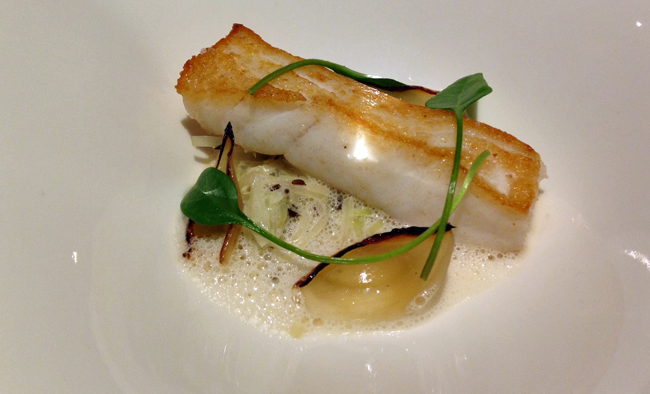
A dish of local wild fallow deer was cooked medium rare to maximise its soft texture and rich gamey flavour. Home grown beets smoked with dried mugwort had both sweetness and herbal aroma. Celeriac puree with its mild, sweet nuttiness and a riot of wilted chard, kale and cavalo nero leaves completed this flavoursome and visually stunning composition. (Wine: Barbera d’Asti “La Court” Superiore, 2011 Michele Chiarlo, Piedmonte, Italy).

The kitchen’s skill and ingenuity do not flag at the dessert stage.
An iced roulade of blackcurrant and chamomile also featured crunchy “fizzy rocks” made from citric sugar to temper the inherent bitterness of blackcurrant sage. Paired with an inspired “cheeky Ribena cocktail” of local vodka, lemon juice and soda water, this was a refreshing and playful palate cleanser.
A dessert focusing on violet was both old fashioned its use of the flower and contemporary in its overall design and flavour. The firm, creamy parfait was scented but not overwhelmed by the floral fragrance – a difficult balancing act successfully achieved. Velvety smooth lemon thyme ice cream added a herbal note, contrasting with the sweetness of the parfait. Delightful miniature meringue “branches” flavoured with blueberries added crispness the dish needed. (Wine: Noble Riesling, 2014, Framlingham Estate, Marlborough, New Zealand)

The final dish was a veritable masterclass of invention and technique, a brilliant marriage of tastes and textures. Delicately poached pears partnered with buttermilk ice cream were complemented by a yogurt crumble and maritime pine powder. This last element, based on a parsley stock syrup infused with pine needles, imparted an Alpine like fragrance and vivid colour, lifting the whole composition. Thin, crisp shards of meringue added height as if to resemble the peaks of a mountainous terrain of which the green of the pine powder were the lower slopes. (Wine: Blenheim Super Ice cider, 2011, Once Upon a Tree, Ledbury, UK)

Good coffee and petit fours – quince jelly and rosemary sugar and macaroons – completed a meal clearly worthy of a Michelin star. Our enjoyment was enhanced by welcoming and solicitous service of the young staff who were fully briefed on the menu and answered questions in a knowledgeable way. Manager and sommelier Andy Stoneley matched wines with consummate skill and assurance. The paired wine service – timed before the arrival of each dish and with clear, brief descriptions devoid of the florid language encountered elsewhere – showed real professionalism.
Chris Harrod and his team have clearly made a strong impact since gaining a much deserved Michelin star. Apart from a loyal local following, The Whitebrook attracts most of its guests from Bristol, Bath, Cheltenham, Birmingham, Cardiff, Hereford and even London, making it a destination restaurant. Since the publication of the 2015 guide (in September 2014), the 32 cover dining room averages 20 diners each night, no mean achievement given its fairly isolated location in a secluded valley on an unnamed narrow and winding road off the A466.
And yet one feels that Chris Harrod is only in the early stages of his independent gastronomic journey. A sharp culinary intelligence with a true understanding of flavour, allied with a fertile imagination and inexhaustible energy will take him much further. We relish the prospect of a future visit and in the meantime will follow his career with interest, anticipating further acclaim from Michelin and other respected guides.







